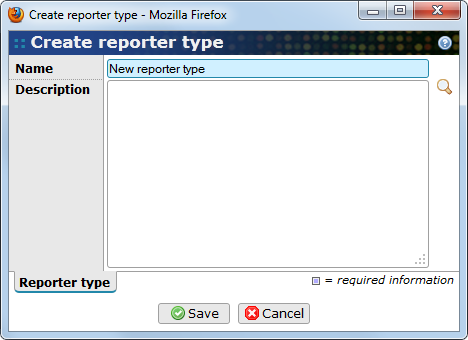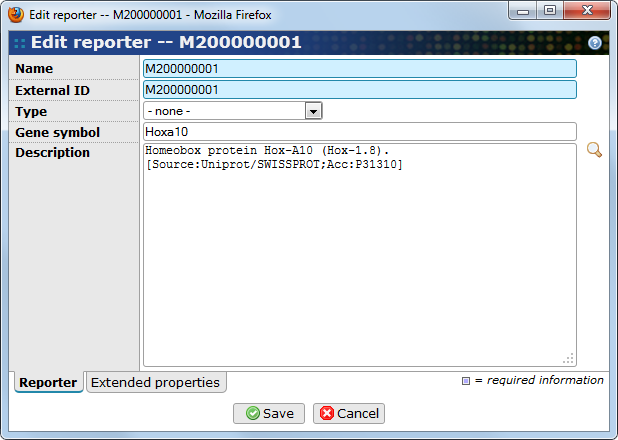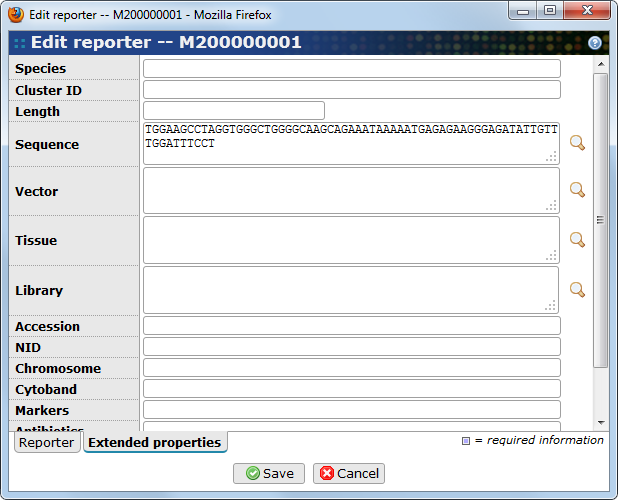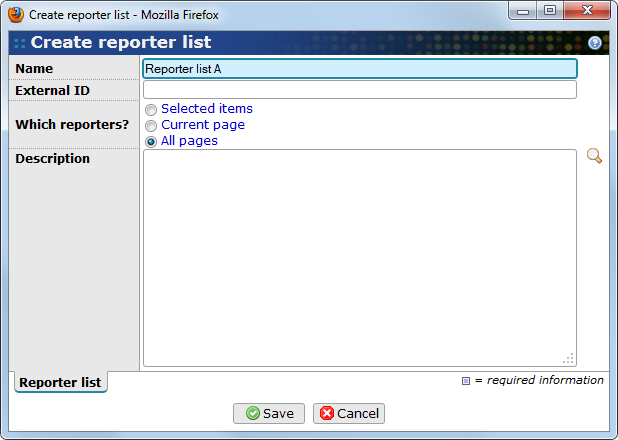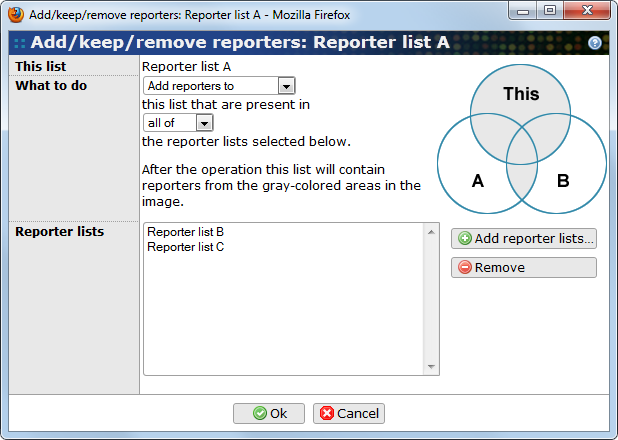Table of Contents
Reporter, a term coined by the MAGE object model refers to spotted DNA sequence on a microarray. Reporters are therefore usually described by a sequence and a series of database identifiers qualifying that sequence. Reporters are generally understood as the thing biologists are interested in when carrying out DNA microarray experiments.
In BASE, reporters also refer to Affymetrix Probeset ID but reporters can be used to describe genes, transcripts, exons or any other sequence entity of biological relevance.
Reporter Type allows classification of reporters based on their usage and qualification defined during the array design specification. You can manage the reporter types by going to .
- Name
-
The name of the reporter type. It is advised to define the name so that it is compatible with the MIAME requirements and recommendations issues by microarray data repositories. Alternately, the local reporter type could be submitted to those repositories for term inclusion.
- Description
-
A description of the reporter type.
Go to to view and manage the reporters.
Reporters are used to represent genes, transcripts, exons and therefore come in their thousands. To solve this problem, BASE relies on Reporter import plug-ins. Those need to be specifically configured to deal with a particular input file format. This input file can be typically be an Axon GAL file or an Affymetrix CSV file which both provide information about reporters and their annotations. See Chapter 19, Import of data for more information about importing and Section 22.2, “Plug-in configurations” for more information about configuring file formats.
![[Note]](../gfx/admonitions/note.png) |
Dealing with Affymetrix probesets |
|---|---|
|
In BASE, Affymetrix probesets should be treated as reporters. The probeset ID could be stored in both the Name and the External ID fields of the reporter table. Storing the probeset ID should be enough as most analysis tools allow retrieval of updated information based on the probeset ID from web resources. For some Affymetrix chips the associated CSV file does not list all reporters on the actual chip. This will lead to problems in later use of the affected chip types. Simply use the associated CDF file to import the missing probesets into BASE, make sure not to upgrade existing reporters when starting the plug-in. |
Reporters can also be created or edited manually one-by-one. This follows the same pattern as for all other items and is described in general terms in Section 5.3, “Working with items”.
This tab shows core information that would be common to all BASE instances.
- Name
-
The name of the reporter. This is often the same as the External ID.
- External ID
-
The external ID of the reporter as it is defined in some database. The ID must be unique within BASE. The external ID is what plug-ins uses to match reporter information found in raw data files, array design files, etc.
- Type
-
Optionally select a reporter type.
- Gene symbol
-
The gene this reporter represents.
Reporters belong to a special class whose properties
can be defined and extended by system
administrators. This is done by modifying the
extended-properties.xml file during
database configuration or upgrade. All fields on
this tab are automatically generated based on this
configuration and can be different from one server
to the next.
See Section 21.2, “Installation instructions”
and Appendix C, extended-properties.xml reference
for more information.
![[Note]](../gfx/admonitions/note.png) |
Note |
|---|---|
|
It is possible to configure the extended properties so that links to the primary external databases can be made. For example, the Cluster ID is linked to the UniGene database at NCBI. |
![[Caution]](../gfx/admonitions/caution.png) |
Deleted reporters cannot be restored |
|---|---|
|
Reporters are treated differently from other items (e.g biosources or protocols) since they does not use the trashcan mechanism (see Section 5.5, “Trashcan”). The deletion happens immediately and is an unrecoverable event. BASE will always show a warning message which you must confirm before the reporters are deleted. |
Reporters which has been referenced to from reporter lists, raw data, array designs, plates or any other item cannot be deleted.
A common problem is to delete reporters that has been accidentally
created. The regular web interface is usually no good since it
only allows you to delete a limited number of reporters at a time. To solve
this problem the reporter import plug-in can be used in delete mode.
You can use the same file as you used when importing. Just select
the delete option for the mode
parameter in the configuration wizard and continue as usual.
If the plug-in is used in delete mode from a reporter list it will
only remove the reporters from the reporter list. The reporters are not
deleted from the database.
![[Note]](../gfx/admonitions/note.png) |
Note |
|---|---|
|
It may be a bit confusing to delete things from an import plug-in. But since plug-ins can only belong to one category and we wanted to re-use existing file format definitions this was our only option. |
BASE allows for defining sets of reporters for a particular use, for instance to define a list of reporters to be used on an array. There are several ways to do so:
-
Use the button on the page. This creates a reporter list with the current selection or filtered out reporters.
-
Use the button on the page. This creates an initially empty reporter list that can be filled later.
-
Use the button on the Features tab on the single-item view page for an array design. This creates a reporter list with all or some of the reporters used on the array design.
-
Use the button on the Raw data tab on the single-item view page for a raw bioassay. This creates a reporter list with all or some of the reporters used by the raw bioassay.
-
Use the button on the Spot data tab on the single-item view page for a bioassay set in the experiment analysis section. This creates a reporter list with all or some of the reporters used by the current bioassay set.
-
Use the button on the Reporter search tab in experiment explorer. This creates a reporter list with all or some of the reporters used by the current bioassay set.
- Name
-
The name of the reporter list.
- External ID
-
An optional external ID. This value is useful, for example, for a tool that automatically updates the reporter list from some external source. It is not used by BASE.
- Which reporters
-
Select one of the options for specifying which reporters should be included in the list. This option is only available when creating a new reporter list, not when editing an existing list. The default is to create a list with all reporters that are in the current list.
- Description
-
A description of the reporter list.
![[Tip]](../gfx/admonitions/tip.png) |
Tip |
|---|---|
|
To add or remove reporters to the list use the Reporters tab on the single-item view page of a reporter list. This tab lists all reporters in the list and there are functions for removing, adding and importing reporters to the list. |
It is possible to modify a reporter list by merging it with other reporter lists. Go to the single-item view page for a reporter list. There should be three buttons in the toolbar corresponding to three main merge variants:
-
Union: Add all reporters from the source lists to the destination list.
-
Intersection: Keep only reporters that are present in all selected lists.
-
Complement: Keep only reporters that are unique for the destination list.
All three buttons open up the same dialog with different default selections.
- This list
-
Shows the name of the current reporter list.
- What to do
-
In this drop-down list you can select if you want to add, keep or remove reporters from the selected list based on if a reporter is present in one or all of some other reporter lists (selected below). The image to the right gives an overview what will happen for the currently selected alternatives. The red-colored areas indicate which reporters that are included in the final list. The white-colored areas indicate reporters that doesn't pass the filter and are excluded from the final list.
- Reporter lists
-
You will need to select at least one more list to merge with.
